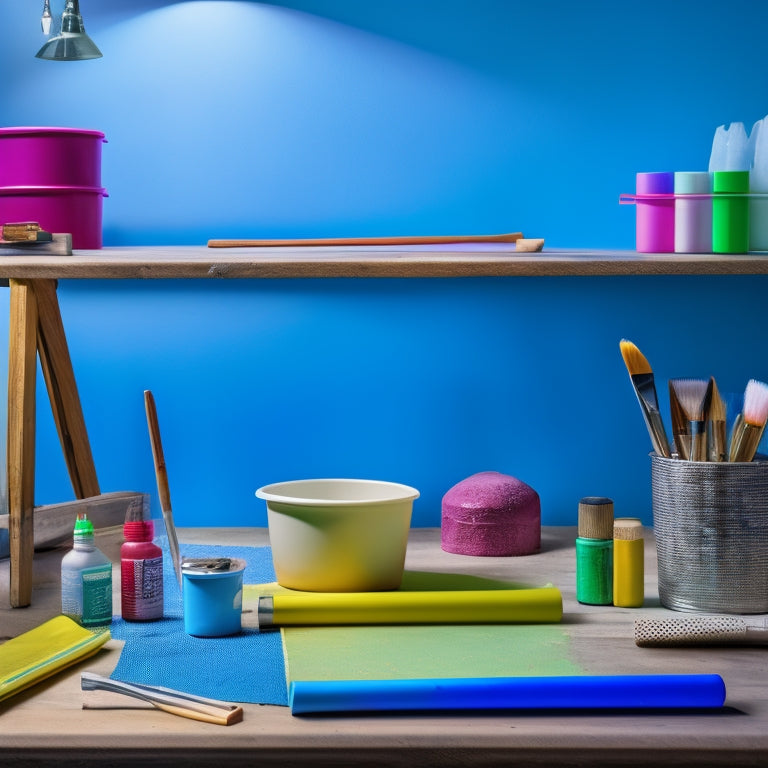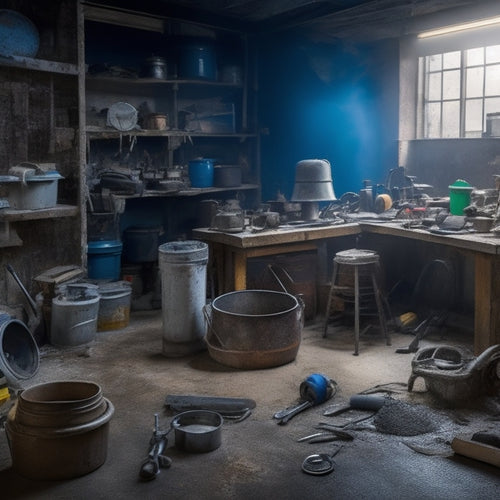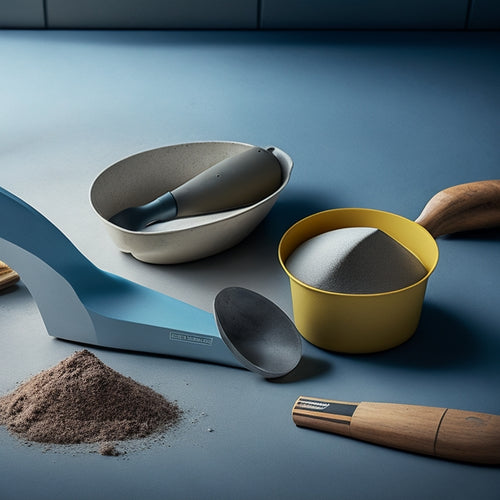
7 Must-Have Tools for Concrete Block Painting
Share
You'll need the right tools to achieve a professional-looking finish on your concrete block painting project. Start with high-quality paintbrushes and rollers, specifically choosing stiff-bristled brushes for rough textures and microfiber rollers for smooth finishes. Don't forget essential protective gear like gloves, face masks, and safety goggles. Measure accurately with cups and sticks, and use masking tape to protect surrounding surfaces. Prepare the surface with cleaning solution and water, and scrub with sandpaper and wire brushes. Finally, lay down drop cloths and tarps to prevent stains and use rags for cleaning up spills. With these must-haves, you'll be well on your way to a flawless finish, and learning more about each tool will guarantee a job done right.
Key Takeaways
• High-quality paintbrushes and rollers are essential for achieving a smooth, even finish on concrete blocks.
• Measuring cups and sticks ensure accurate measurement of painting supplies to avoid uneven finishes.
• Masking tape protects surrounding surfaces and ensures clean paint lines during the painting process.
• Surface preparation tools like cleaning solution, sandpaper, and wire brush ensure a strong bond between the paint and concrete.
• Protective gear, including gloves, face masks, and safety goggles, are crucial for safety during the painting process.
High-Quality Paintbrushes and Rollers
You'll need high-quality paintbrushes and rollers specifically designed for concrete block painting to achieve a smooth, even finish.
When it comes to paintbrush types, look for ones with stiff bristles that can handle the rough texture of concrete blocks. Natural bristle brushes are ideal for oil-based paints, while synthetic brushes work better with water-based paints. For cutting in and painting corners, use a high-quality angled brush.
For larger areas, you'll need rollers with the right nap length and material. Microfiber rollers are excellent for smooth finishes, while foam rollers are better suited for textured surfaces. Use a roller extension pole to reach high areas and reduce fatigue.
When it comes to roller techniques, work in sections, using a 'W' or 'M' pattern to guarantee even coverage. Apply moderate pressure, and avoid using too much paint to prevent drips and unevenness.
Protective Gear for Safety
With your painting tools in hand, it's time to gear up with the necessary protective equipment to secure your safety while working with concrete block paint.
As you prepare to tackle your project, remember that safety regulations are in place for a reason. Don't compromise your well-being by neglecting to wear the right gear.
You'll need a pair of gloves to protect your hands from harsh chemicals and rough surfaces. Look for ones made from durable materials like nitrile or latex.
A face mask or respirator is also essential to prevent inhaling paint fumes and particles. Make sure it fits snugly and has a proper filter.
Don't forget to wear safety goggles or glasses to shield your eyes from splatters and spills. Additionally, consider a protective suit or apron to keep your clothes clean and stain-free.
Regular gear maintenance is vital to guarantee your equipment remains effective. Clean and inspect your gear regularly to prevent damage and degradation.
Cleaning Solution and Water
When preparing your concrete block surface for painting, you'll need a suitable cleaning solution and water to get the job done right.
You'll want to mix the solution to the right ratio to avoid damaging the surface, and then use it to thoroughly clean the block to guarantee a smooth paint job.
Mixing Ratio Guidance
To achieve an effective cleaning solution, mix one part trisodium phosphate (TSP) with four parts warm water in a bucket. This mixing ratio is vital, as it guarantees the solution is potent enough to remove dirt and grime without damaging the concrete blocks.
When you're mixing, make sure to stir the solution thoroughly to avoid any undissolved TSP particles. This will help maintain a consistent cleaning solution that won't leave streaks or residue on your blocks.
As you're preparing to paint, it's important to take into account the paint consistency. You want a smooth, even finish, and that starts with the right mixing techniques. Aim for a consistency similar to thick cream – not too runny, not too thick.
If you're unsure, it's always better to err on the side of caution and add a little more water. You can always adjust the consistency as needed, but it's harder to fix a mixture that's too thin.
Surface Preparation Tips
You'll need to apply the cleaning solution you mixed earlier to the concrete blocks, making certain to saturate the entire surface thoroughly.
Use a stiff-bristled brush or broom to work the solution into the surface texture, paying special attention to any areas with heavy buildup or stains. Let the solution sit for 10-15 minutes to allow it to penetrate and loosen any dirt or grime.
Next, use a pressure washer or hose to rinse the blocks, making certain to remove all soap residue. It's essential to remove any remaining soap, as it can affect paint adhesion. Use a wide fan tip and keep the nozzle at least 12 inches away from the surface to avoid damaging the blocks.
Once the blocks are clean and rinsed, use a clean towel or rag to remove any excess water. You want the surface to be damp, but not soaking wet, before applying primer or paint.
Sandpaper and Wire Brush
Sandpaper and a wire brush are essential tools for preparing your concrete blocks for painting, as they help remove dirt, grime, and old coatings that can interfere with paint adhesion.
When it comes to sanding techniques, you'll want to start with a coarse grit sandpaper (around 80-100) to remove any loose debris or old paint. Gradually move to finer grits (120-150) for a smoother finish. Always sand in a circular motion, working your way up to avoid scratching the surface.
For tougher grime or stubborn coatings, you'll need a wire brush. There are various brush types to choose from, including stiff-bristled brushes for heavy-duty cleaning and softer-bristled brushes for more delicate surfaces. Use a wire brush to scrub away stubborn dirt and grime, working in small sections to maintain control.
Remember to always wear protective gear, including gloves and safety glasses, when working with sandpaper and wire brushes.
Drop Cloths and Tarps
When you're painting concrete blocks, you'll want to make certain you're protecting surrounding surfaces from paint spills and stains.
You'll need drop cloths and tarps to prevent damage to floors, walls, and other areas you don't want to paint.
Protecting Surrounding Surfaces
Before painting your concrete blocks, lay down drop cloths and tarps to shield surrounding surfaces from paint spills and splatters. This vital step guarantees that your surface coverage techniques don't compromise the surrounding area. Take surrounding area precautions seriously to avoid costly repairs or replacements.
| Surface Type | Tarp/Drop Cloth Size | Additional Precautions |
|---|---|---|
| Grass/Lawns | 10' x 20' | Use lawn protection film or plastic sheets to prevent paint from seeping into the soil |
| Driveways/Walkways | 12' x 15' | Tape down the tarp to prevent wind from lifting it, and use sandbags for added weight |
| Patios/Decks | 15' x 20' | Cover any furniture or plants, and use a tarp with a non-slip backing to prevent slipping |
| Sidewalks/Curbs | 10' x 10' | Use a tarp with a rubber backing to prevent slipping, and tape it down securely |
| Windows/Doors | 5' x 5' | Use a smaller tarp or drop cloth, and tape it securely to the window or door frame |
Remember to choose the right size and type of tarp or drop cloth for your specific surface, and take additional precautions as needed. By protecting your surrounding surfaces, you'll guarantee a smooth and successful concrete block painting project.
Preventing Stain Damage
You've taken the necessary steps to protect surrounding surfaces, and now it's time to focus on preventing stain damage with the right drop cloths and tarps.
When it comes to concrete block painting, stain resistance techniques are vital to maintaining a professional-looking finish. Drop cloths and tarps are essential tools in your arsenal, providing a moisture barrier application that prevents paint spills and stains from seeping into the surface.
When selecting a drop cloth or tarp, look for materials that are waterproof, durable, and resistant to tears. A high-quality drop cloth will also have a non-slip backing to prevent it from shifting during the painting process.
Additionally, consider the size of the area you're working on and choose a drop cloth or tarp that provides adequate coverage. By using the right drop cloths and tarps, you'll be able to contain any paint spills or stains, making cleanup a breeze and ensuring a flawless finish.
Don't risk compromising your work – invest in the right tools to get the job done right.
Measuring Cups and Sticks
Measure your concrete block painting supplies accurately with measuring cups and sticks to confirm a perfectly mixed coating.
When it comes to concrete block painting, precision is key. You can't afford to mess up the mixture, or you'll end up with an uneven, unprofessional-looking finish. That's where measuring cups and sticks come in. These tools guarantee that you're using the right amount of each ingredient, every time.
To achieve measurement accuracy, make sure you:
-
Use measuring cups specifically designed for painting supplies
-
Clean and dry your measuring cups and sticks after each use
-
Follow the manufacturer's instructions for measuring techniques
- Double-check your measurements before mixing the coating
Masking Tape and Rags
With your coating mixture perfectly mixed, now it's time to prepare your concrete blocks for painting by protecting surrounding surfaces with masking tape and rags.
You'll want to apply the tape carefully, using techniques like pressing it firmly onto the surface to guarantee a strong bond. Make sure to apply it in a straight line, and smooth out any air bubbles or wrinkles. For areas with complex shapes or curves, use a specialized tape designed for those situations.
When it comes to rags, you'll need them to wipe up any spills or drips. To maintain their effectiveness, wash and dry them regularly. You can also reuse them multiple times by storing them in a sealed container or bag.
Remember to always handle rags with clean hands to prevent transferring dirt or debris to your painting surface. By following these tape application techniques and rag maintenance tips, you'll be able to contain your paint job and achieve a professional-looking finish.
Frequently Asked Questions
Can You Paint Concrete Blocks in Cold Weather?
When painting concrete blocks in cold weather, you'll need to adjust your approach.
Make sure the surface temperature is at least 40°F (4°C) for ideal paint adhesion.
Use specialized cold-weather paint or add a retarder to slow down drying time.
Apply thin coats, allowing each layer to dry before adding the next.
Avoid painting in direct sunlight or during extreme cold snaps, as this can cause uneven drying and poor adhesion.
Do I Need to Prime the Concrete Blocks First?
Think of priming concrete blocks like prepping a canvas for a masterpiece. You wouldn't start painting without a smooth surface, right?
The same applies here. You need to prime those blocks first to guarantee a strong bond between the paint and the concrete. Proper surface preparation is key, and that means applying the right primer type.
Don't skip this step, or you'll risk peeling and flaking. Trust us, it's worth the extra effort.
How Long Does It Take for the Paint to Dry?
You're wondering how long it takes for the paint to dry.
Well, the drying time depends on the type of paint you're using.
Latex paint typically takes 1-2 hours to dry to the touch, while oil-based paint can take up to 24 hours.
Additionally, environmental factors like temperature, humidity, and airflow also impact drying time.
Make sure to follow the manufacturer's instructions for specific guidance.
Can I Use a Spray Gun to Paint the Blocks?
Get ready to release your inner artist! When it comes to painting concrete blocks, you're wondering if a spray gun is the way to go. The answer is yes, but with caution.
Opt for an HVLP (high volume, low pressure) or LVLP (low volume, low pressure) spray gun for a smooth finish. Master various painting techniques, such as thin coats and gentle sweeps, to achieve a professional look.
Just remember to choose the right spray gun type and technique to avoid uneven coverage and overspray.
Do I Need to Seal the Paint After It's Dry?
You're wondering if sealing the paint is necessary after it's dry. The answer is yes, to guarantee paint durability.
Unsealed paint can chip or fade quickly, especially on concrete blocks exposed to the elements.
You'll want to explore sealing options, such as acrylic or polyurethane-based sealers, to protect your hard work.
Apply a clear coat according to the manufacturer's instructions to lock in the color and guarantee a long-lasting finish.
Conclusion
With your arsenal of must-have tools, you're ready to transform drab concrete blocks into vibrant works of art.
Imagine the rough, grey surface surrendering to a kaleidoscope of colors, as your brushstrokes bring new life to the mundane.
The sweet scent of paint and the gentle hum of creativity fill the air, as you step back to admire your masterpiece.
With the right tools, the possibilities are endless, and your concrete block canvas is waiting.
Related Posts
-

7 Tools to Fix Damaged Concrete Floors
You're about to tackle that damaged concrete floor, and the right tools are essential for a successful repair. Start ...
-

Ergonomic Concrete Tools for Tight Spaces
When you're tackling concrete work in tight spaces, ergonomic tools are your best bet for comfort and efficiency. The...
-

Top Mixing Tools for DIY Concrete Block Laying
When it comes to DIY concrete block laying, the right mixing tools are vital for a strong and durable structure. You'...


